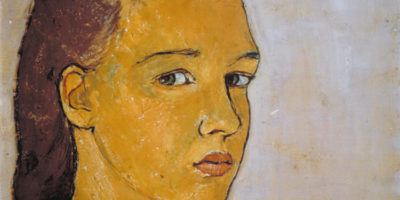The Huppah Quilting Bee
A clip-and-save wedding project
When Sharon Goldman and Sandy Edry began planning their wedding, they decided to pay special attention to their huppah. They wanted— somehow—to end up with a Jewish ritual object that would (in their written words to guests), “hang over our heads during our ceremony, be displayed during our reception, and also, we hope, be a wonderful heirloom that will be a part of our household for many years to come.”
And so they began their huppah journey by contacting several official New York huppah artists. “These artists work in silk, twine, a tallit, anything you want,” explains Sharon. “They charge between $1000 and $3000, and think up a whole concept for the huppah. I realized that I already knew my design idea—squares on a grid, a kind of community ‘quilt.’ We didn’t need a huppah artist; we just needed someone who could sew a quilt together.”
Luckily, Sharon’s mother, Marilynn Goldman (who sewed clothes for her children when they were small) volunteered for the task. Mother and daughter practiced standing under imaginary huppahs and juggling squares around on grid paper. They decided upon a huppah that would be 6’x6′, comprised of 30 squares (11″ each), with a big square in the center (20″x2()”) embossed with the bride and groom’s Hebrew names and the wedding date.
Next, Sharon and Sandy mailed 30 small squares of cotton fabric to close friends and family to decorate as they saw fit. In a loving letter they advised: “Take heart. We are aware how busy people are, and how levels of creativity differ. Here are guidelines to make this task as easy as possible. We truly hope that this is not an inconvenience. It’s just that you are the people that we treasure most in our lives, and we really want you to be a special part of our wedding.”
Guidelines (derived from Sharon and Marilynn’s educational safaris to fabric stores) included, says Sharon, “explaining the possibilities—photo transfer, liquid embroidery, fabric pen, iron-on applique. Only one taboo: NO GLUE. We wanted to make sure we could dry-clean the huppah; that it would last a lifetime.”
As finished squares began arriving by return mail, Sharon, Sandy and Marilynn got excited. Sandy’s mother, moved by what she considered to be a holy task, took one square and divided it into quadrants for Sandy’s young half-siblings to work on. Orthodox cousins in Israel, who were pleased to be included, took Sharon aback by enjoining her, on their square, to remember to practice the laws of family purity.
A best friend of Sharon’s from kindergarten taught herself embroidery specifically for the occasion, and another best friend (who got married a few weeks before the Goldman/Edrys) used fabric paints to cartoon a version of all four nuptial partners under one huppah.
The bride’s California grandmother (“the afghan-crocheter”) sewed a tiny woolen afghan on her square, while Sharon’s other grandmother (“the Florida knitter”) affixed two miniature matching knitted sweaters for bride and groom. Says Sharon, “There was no question about what my grandmothers would do, and that was nice.”
Sharon’s father, a collector of El-Al memorabilia (no kidding), went to a T-shirt store and heat-transferred a picture of an El-Al plane flying over Tel Aviv which reads in Hebrew, “The path to success.”
The groom’s father used his square to reproduce a short story that Sandy (the writer-to-be) had composed at age seven, while another “writer”-inspired offering came from the groom’s dear friend who had been editor-in-chief of the college paper while Sandy had been number two. On the huppah, the friend photo-transferred the masthead, generously reversing their two names for posterity.
A close friend of Sharon’s from Israel cut up a folk embroidered purse of hers that Sharon had always admired, and two of Sandy’s friends, feeling artistically intimidated, commissioned a professional artist to do their exquisite square— the Jerusalem Temple on a wedding ring, encircled by Hebrew text.
Finally, Sharon’s sister, a physical anthropologist, painted her square with two pre-modern monkeys and the inscription: “Two cercopithecoids sitting in a tree . . ” [k-i-s-s-i-n-g]. Sharon’s close friend since her bat mitzvah—her dog Minnie—used her square (a traditional Amish ‘wedding band’ patch) as backdrop for a signature paw print.
The most gratifying moment for Sharon came the week before the wedding. Twenty or so family and closest friends arrived at Sharon’s parents’ house for a “huppah quilting bee.” Around bagels and pasta salad, the ever-shifting group spent hours sewing around each square, securing batting, and giving the huppah, in Sharon’s words, “that quilty, puffy look.”
“It was a wonderful afternoon of communal surround,” says Sharon. “My grandmothers were there, my mother and mother-in-law, my aunt and cousin, Sandy’s little half-siblings, my three best friends, my sister. The males were supposed to participate, too, but they contracted Fear-of-Sewing disease, so they watched T.V. in the other room. Sandy actually did a few stitches but then ran away when we started talking about makeup. Actually, I was happy that it ended up being a female thing.”
“It was great to feel how devoted our family and friends were to the project. My girlfriends sewed for hours and hours. The huppah was wonderful to look at as it developed, so a lot of people stopped by just to look.”
In the letter that Sandy and Sharon had months earlier sent to their closest family and friends they wrote, “We hope that when the squares come back we will have memories to last forever. We love you all and can’t wait for you to dance at our wedding!”
Sharon Goldman Edry is happy to share her huppah-making hokhmah [wisdom] with others. She can be contacted at: 224 Riverside Dr., Apt. 7B, NY, NY 10025. 212-663-1864.


